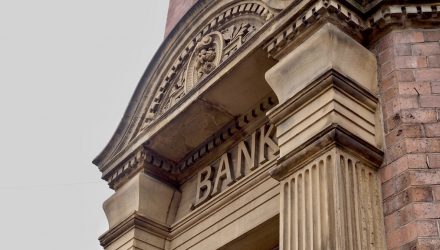U.S. stocks blasted higher on Tuesday, and are continuing their run today, snatching back points from a big beating over the past month, after Federal Reserve Chairman Jerome Powell intimated Tuesday that the central bank was open to relaxing its monetary policy to save the economy, and as trade tensions eased amid comments by China and Mexico.
“The market wanted to hear from Powell. When Powell says ‘we are watching the market’ — whether it’s right or wrong — the market starts believing in a Powell put,” said Keith Lerner, chief market strategist at SunTrust Private Wealth. He also noted “sentiment became extremely negative on a short-term basis.”
But despite the unbridled optimism that traders and investors are exhibiting, there is one sector of the market that could suffer if the Fed does opt to cut rates: bank stocks.
Large-cap banks could see their earnings on a per share basis decline by 10%, on average, if the Fed cuts rates by 75 basis points, according to Bank of America Merrill Lynch.
”…Lower short-term rates are expected to negatively impact bank earnings,” said Erika Najarian, financials analyst at Bank of America said in a note on Wednesday. “Feedback from bank management teams implies mixed sentiment over the ability to cut deposit rates quickly.”
That means banking ETFs like the Financial Select Sector SPDR ETF (XLF), Vanguard Financials ETF (VFH), and the iShares U.S. Financials ETF (IYF), all of which have had solid performance over the past year, could find themselves languishing.
The problem for banks is that their profit margins could suffer if they are paying out deposit rates at a higher level than market rates. Their earnings are also damaged when the spread between short-term and long-term rates flattens, a phenomenon that could likely worsen if the Fed cuts further.
Bank stocks encountered trouble already recently as Treasury yields fell in May on concerns of a slowing global economy. The SPDR S&P Bank ETF (KBE) lost 10% in May as the yield on the 10-year Treasury note was beaten back 14% last month. A segment of the yield curve also inverted while the broadening trade war between the U.S. and China, and now also Mexico has been occurring, marking a recession signal watched by the Fed and other economic experts.
Still, Powell was not absolute in his statement, suggesting a wait and see approach to rate cuts. He remarked, that the Fed is not clear “how or when” global trade issues will be resolved. “We are closely monitoring the implications of these developments for the U.S. economic outlook.”
For more investing strategies, visit ETFtrends.com.

